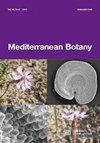Amino and fatty acids composition of olive stones for the discrimination of 'Olea europaea' subsp. 'europaea' varieties
IF 0.7
4区 生物学
Q3 PLANT SCIENCES
引用次数: 1
Abstract
Few studies have reported the relationship between wild (Olea europaea L. subsp. europaea var. sylvestris) and cultivated (Olea europaea L. subsp. europaea var. europaea) olive trees by using diverse markers. Herein, the amino and fatty acids composition of stones from wild and cultivated olives were assessed respectively using amino acids analyzer and gas chromatography coupled with mass spectrometry. Stones of 24 Tunisian olive samples including twelve cultivated trees and twelve wild trees were obtained from olives harvested at ripe stage. Results showed that 17 amino acids (with eight essential amino acids) and 15 fatty acids (eight saturated and seven unsaturated) were detected in the both olive taxa. Statistically, significant differences among wild and cultivated stones were observed for amino and fatty acids contents. Based on the major fatty acids and the essential amino acids, multivariate analyses classified olive varieties into three groups showing a close relationship between some wild and cultivated olive trees. Results were useful to distinguish some interest wild olive genotypes having stones richer in essential amino acids and monounsaturated fatty acids. Wild olive trees would constitute a genetic pool of interest criteria. These data would be used as complementary tool to morphological traits and molecular markers studies providing a relationship between the cultivated and wild olive trees.橄榄核的氨基酸和脂肪酸组成用于鉴别“橄榄油”亚种欧洲品种
很少有研究通过使用不同的标记来报道野生橄榄树(Olea europaea L.subsp.europaea var.silvestris)和栽培橄榄树(Olea europaea L.subsp.eurapaea var.europaa)之间的关系。本文采用氨基酸分析仪和气相色谱-质谱联用技术分别对野生橄榄和栽培橄榄核的氨基酸和脂肪酸组成进行了评价。从成熟期收获的橄榄中获得了24个突尼斯橄榄样品的石头,包括12棵栽培树和12棵野生树。结果表明,在两个橄榄类群中都检测到17种氨基酸(包括8种必需氨基酸)和15种脂肪酸(8种饱和和7种不饱和)。从统计数据来看,野生和栽培石头的氨基酸和脂肪酸含量存在显著差异。根据主要脂肪酸和必需氨基酸,多元分析将橄榄品种分为三组,表明一些野生橄榄树和栽培橄榄树之间存在密切关系。结果有助于区分一些感兴趣的野生橄榄基因型,这些基因型具有富含必需氨基酸和单不饱和脂肪酸的果核。野生橄榄树将构成一个感兴趣的基因库标准。这些数据将被用作形态特征和分子标记研究的补充工具,以提供栽培和野生橄榄树之间的关系。
本文章由计算机程序翻译,如有差异,请以英文原文为准。
求助全文
约1分钟内获得全文
求助全文
来源期刊

Mediterranean Botany
Agricultural and Biological Sciences-Plant Science
CiteScore
2.40
自引率
10.00%
发文量
30
审稿时长
12 weeks
期刊介绍:
Mediterranean Botany (ISSNe 2603-9109), formerly Lazaroa, is a biannual journal that publishes original research studies in the field of Botany including plant systematics, vegetation ecology, biogeography, evolutionary biology, ecophysiology, community ecology, ethnobotany and conservation biology on Mediterranean biomes but also in interacting areas.
Mediterranean Botany is an OPEN ACCESS Journal, free of charges for any published article.
 求助内容:
求助内容: 应助结果提醒方式:
应助结果提醒方式:


